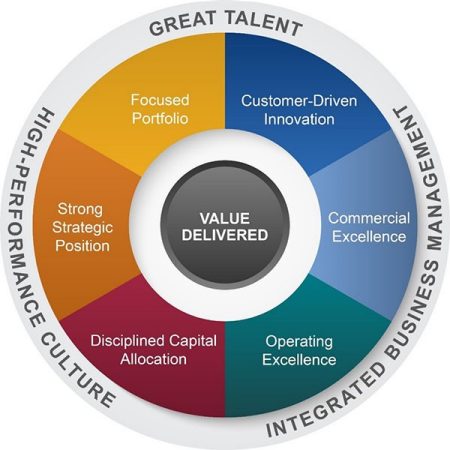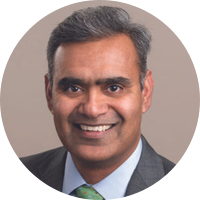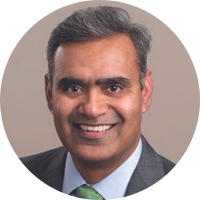
Key Takeaways:
- Jag Reddy shares what he plans on accomplishing as Managing Director of a joint venture between W.R. Grace & Co. and Chevron
- Reddy share how he handles multi-tasking in terms of growth
- How trust comes into play when making a successful team leader
You’re currently serving as Managing Director of a joint venture between W. R. Grace & Co. and Chevron called Advanced Refining Technologies, LLC (ART). What are you trying to accomplish through this joint venture?
As a 50/50 JV between Chevron and Grace, ART is a market leader in hydroprocessing catalyst technologies for the refining market. The demand for ART products is the result of stringent environmental standards in emerging economies and the need for greener fuels. By coming together, we serve our customers with best technologies and technical service, both from Chevron and Grace, to optimize their refining operations.
In addition to your role leading the joint venture with Chevron, you have another role with Grace: Vice President, Strategy and Growth. In that role, you are responsible for leading the company's global strategy and growth process, as well as key growth priorities, including strengthening Grace's innovation, commercial, and manufacturing capabilities. Sounds like you must be pretty skilled at multi-tasking. Care to share some tips with us?
At Grace, our focus is on executing the Grace Value Model [appears below], which clarifies priorities for the corporation – Customer-driven Innovation, Strong Strategic Positions, and Focused Portfolio.
In order to be successful, a strong team as well as CEO support and commitment to technical leadership are critical. Fortunately, we have both. We leverage our annual Growth Plan process to confirm our priorities and make strategic decisions on investments. My S&G role ensures that the Grace Leadership Team includes a leader with a clear “growth” portfolio along with our business presidents. As for managing multiple initiatives, I work closely with very talented cross-functional teams that bring forth solutions, not just challenges. That makes it possible for me to prioritize and delegate key actions.

On the subject of the joint venture with Chevron, do enough companies seek to achieve their goals through partnerships? Or do too many reflexively seek to compete first, and look for partnership opportunities only as a last resort?
Our industry is unusual, if not unique, in terms of the diversity of relationships; sometimes companies are both a customer and a supplier, some are joint venture partners, some form joint development agreements, others are licensors and licensees or both, others even occasionally “toll” for each other, i.e., another manufacturer makes the product for the OEM. If a company is not open to these relationships, and if a company is clumsy at it or if “transaction costs” are out of control, then they are at a major disadvantage. At ART we constantly strive to limit governance challenges and focus on what’s critical – being indispensable to our customers and delivering value to all stakeholders.
Among other responsibilities, you are in the business of leading teams. What makes for a successful leader of teams?
A JV presents unique team leadership challenges, as many of the team members are in a matrix reporting relationship. Their manager in the JV is different from their “boss” at the parent company. For the team to be successful, leaders must trust each other and decentralize decision making. For the ART team, focusing on delivering value to our customers takes priority, and with a shared objective many other issues are more easily resolved.
We begin by acknowledging that partner goals, culture, business processes, etc. differ but we never lose sight of what we share: safety first, technical leadership, and customer focus. As for managing working teams, at ART we’ve learned a lot over 19 years, including the value of a clear charter; seats at the table; and especially, respect and trust.
How have your parents influenced your leadership style?
Interesting that you ask about my parents. My parents instilled in me the importance of education, hard work, and respect for others. Many of the mentors I look up to gave me a sense of purpose and accountability. These values have stayed with me and I trust them to help me navigate complex challenges.
With respect to your scientists at Grace, what non-technical skills do you most highly value?
First, it’s important to remember that ART includes research scientists from both Chevron and Grace, and they form the core of scientific innovation. In the Grace Value Model, we talk about Great Talent and our High-performance Culture.
Unless a technical person is also a talented collaborator and communicator, their technical skills alone will not achieve the best results—for themselves or the JV. We expect everyone, including our scientists, to be team players, able to see the big picture and align with business goals. At both Grace and ART—and, I believe at Chevron—team success is more important than individual success.
What technology trends are you following most closely with an eye toward how they may impact the work of your scientists, and Grace’s future growth?
As NYU Professor Scott Galloway writes in his new book, Post Corona, “the pandemic has not been a change agent but an accelerant of trends already well underway.” This applies to industries, companies, customers, and governments.
At Grace, approximately 44 percent of total 2019 revenues were from products that help our customers meet their sustainability goals, and of course, 100 percent of ART’s revenue comes from products used in production of cleaner fuels. As our customers begin their energy transition, we are working on technologies that will help achieve sustainability goals, including carbon footprint reduction and plastics circularity.
In addition, we are closely monitoring digitalization trends that will disrupt industrial supply chains, monetize technical/customer service offerings, and shorten order-to-cash cycles.
In a previous ACS Boss Talk, Cabot’s Patricia Hubbard wrote the following: “This is the real challenge for Cabot and any company over the long term: How to strike the right balance between keeping a strong core while also building from positions of strength to progress into new areas. It’s hard to get right, but vitally important.” Do you agree with Patricia? And if so, how do you approach this challenge?
Of course, no one in our industry can afford to rest on core positions. I go back to the elements of Grace Value Model that help us clarify our focus and investments.
Customer-driven Innovation means we are focused on what customers want to buy, not on what we currently have to sell. This drives us to constantly understand customers’ needs and develop solutions to their critical problems.
Strong Strategic Position provides effective guard rails and guidance for what we know will be successful and what will deliver real leverage from core Grace capabilities.
And Focused Portfolio does the same in a different way. This is about understanding core and adjacent markets, strategic positions and constantly refining the portfolio to maximize returns to our shareholders.
This framework has helped Grace to exit some businesses and expand into other segments over our long history.
What are some personality traits that have been most instrumental in your career success?
Early in my career, I learned the importance of consensus building and teamwork. Humble leadership is important to me … listening is a powerful tool and it’s contributed so much to the success my teams have enjoyed.
What have you learned about yourself since the start of the pandemic?
I’ve learned I don’t need some of the things I thought I needed. I cherish small things in life such as a stroll through the neighborhood or a quiet family meal at home. I have a deeper appreciation for some things I probably took for granted … face-to-face and casual or informal collaboration with my team. And despite all we now do virtually, I miss the personal connections with customers.
You served on the Board of Governors of the Children’s Theatre Company. How did you come to be interested in that role?
Children are the future and I strongly believe that arts and culture help develop children into well-rounded individuals. I am a supporter of STEAM, including “A” for arts!
The Children’s Theater Company in Minneapolis is a wonderful place that welcomes everyone and is a beacon of hope in the community. CTC brings together multi-generational membership to explore current day issues. It’s renowned for its programming including many original productions. I served on the strategy and executive committees while I was on the Board and leveraged my business skills to help the CTC advance its mission.
One thing I’ve come to believe is that excellence is fun. We’re best at what we love most. And we love most what we’re good at. This is a wonderful setting to help others discover this powerful life lesson.
As of January 2024, Jag Reddy serves as President and CEO at MEC.

As Vice President, Strategy and Growth and a member of Grace's senior leadership team, Jag Reddy leads the company's global strategy and growth process. He is responsible for key growth priorities, including strengthening Grace's innovation, commercial, M&A, and manufacturing capabilities, and aligning growth initiatives with the Grace Value Model. He also serves as leader of the company's Asia Pacific region. Jag joined Grace in 2018.
In addition to his role with Grace, in 2019, Jag was named Managing Director of Advanced Refining Technologies LLC (ART), Grace's hydroprocessing joint venture with Chevron. He is the senior executive of the joint venture and responsible for the overall performance of the business as well as the management of resources provided by the parent companies, Chevron and Grace.
Prior to joining Grace, Jag served as Vice President and General Manager, Water Technologies Strategic Business Unit, and Vice President, Corporate Strategy at Pentair PLC. Previously, he held strategy and business leadership roles at ITT Corporation and its spin-off, Xylem Inc., including strategic leadership roles in the company's China, India, Middle East, and Latin America markets. Before ITT, he spent time in M&A roles with United Technologies Corp. He also held product management and P&L responsibilities with Danaher Corporation. Jag started his career in operations at Denso Corporation.
Jag earned an MBA in finance and strategy from the Kellogg School of Management and a Master's in engineering management from the McCormick School of Engineering, both at Northwestern University. He also holds a Master's in Industrial Engineering from the University of Tennessee and a Bachelor's in Mechanical Engineering from India.
This article has been edited for length and clarity. The opinions expressed in this article are the author's own and do not necessarily reflect the view of their employer or the American Chemical Society.
Copyright 2020 American Chemical Society (All Rights Reserved)












